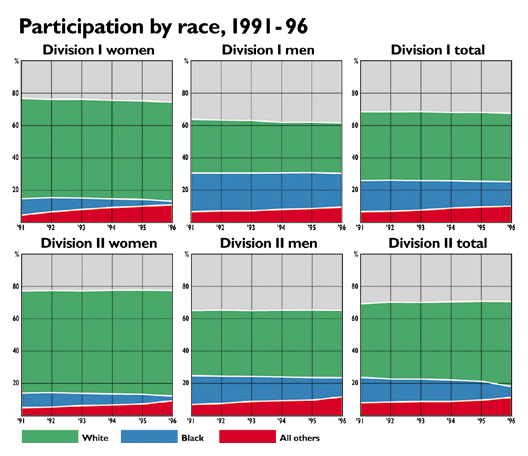
National Collegiate Athletic Association |
The NCAA News DigestApril 12, 1999
Participation by race, 1991-96
Data compiled from NCAA Divisions I and II graduation-rate reports show that the percentage of students receiving athletically related aid has increased the most for those who are neither white nor African-American. In Division I, undergraduate enrollement data for 1996 showed that 66.1 percent of all aid recipients were white and 24.2 percent were African-American. At the beginning of the decade, 67.6 percent were white and 25.2 percent were Black. However, receipt of athletically related aid for members of other ethnic groups increased from 7.2 percent in 1991 to 9.8 percent in 1996. In Division II, the percentage of white students receiving athletically related aid increased by less than one percent from 1991 to 1996 while the percentage of black students receiving athletically related aid dropped from 23.3 percent to 18.8 percent. Representatives of other ethnic groups receiving athletically related aid jumped from 7.1 percent in 1991 to 10.8 percent in 1996. No comparable figures are available for Division III since athletically related aid is not permissible in that division.
LITIGATIONNCAA receives favorable rulings in two significant court casesn The 3rd U.S. Circuit Court of Appeals has granted the NCAA's motion to stay the ruling in Cureton v. NCAA until the appeal is heard. The March 30 decision reestablishes the provisions of legislation commonly known as Proposition 16, which uses minimum SAT and ACT score cutoffs to determine initial eligibility for incoming college freshmen student-athletes in Division I. On March 8, U.S. District Judge Ronald L. Buckwalter ruled that Proposition 16 had an unjustified disparate impact on African-Americans. Buckwalter also denied the NCAA's initial request for a stay as well as the NCAA's request that the ruling apply only to the named plaintiffs in the case. Because the judge's ruling was effective immediately, the NCAA on March 18 sought a stay from the appeals court to stabilize what it believed to be a potentially chaotic state of initial-eligibility standards. The NCAA also has prevailed in a major legal case involving its authority to establish standards for logos appearing on uniforms. A U.S. district court judge on March 26 denied a motion by Adidas America Inc. for a preliminary injunction that would have prevented the Association from enforcing a bylaw that limits the size of logos on uniforms. Judge G.T. VanBebber ruled that Adidas had failed to show sufficient likelihood that it faced irreparable harm without a preliminary injunction or that a lawsuit would prevail on the merits of its claims. Staff contact: Elsa Kircher Cole.
SPORTS PARTICIPATIONAnnual NCAA research to be done later this year The annual study on NCAA sports participation will be compiled in the summer this year rather than in the spring, as has formerly been the case. The change in the publication schedule of sports participation statistics is part of an effort to provide more consistent comparison between data provided through the Equity in Athletics Disclosure Act and the NCAA's published participation rates. Staff contact: Janet M. Justus. |
